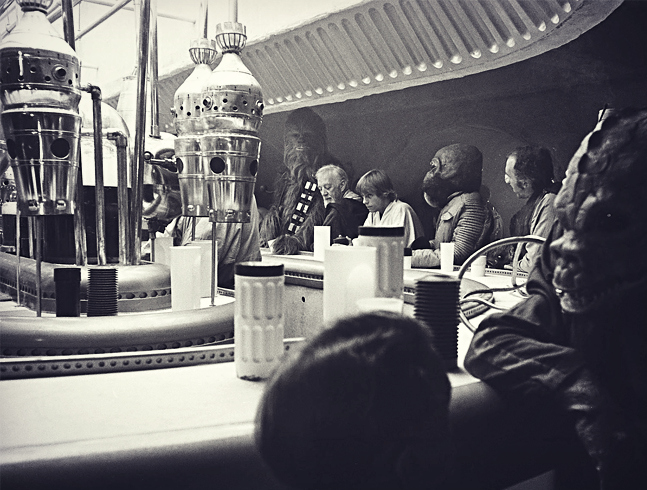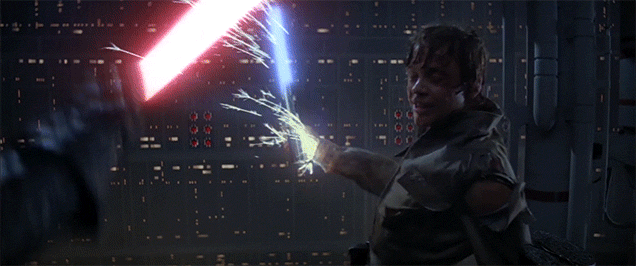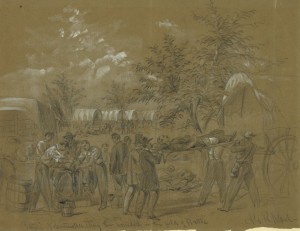The Force is Strong with Civil War Medicine
There’s a catch phrase at the National Museum of Civil War Medicine: “Civil War medicine … it’s not what you think.” That’s because, traditionally, Hollywood has done a really lousy job of representing the reality of Civil War medicine: anaesthesia was used, nobody bit any bullets, etc.
However, as Star Wars fever sweeps the nation, the staff of the National Museum of Civil War Medicine and the Clara Barton Missing Soldiers Office Museum are realizing that there are more connections between the American Civil War and Galactic Civil War than one would think.
Jake Wynn and Amelia Grabowski sat down to explore the connections between medicine a long, long time ago in a galaxy far away and medicine 150 years ago on a battlefield near you.
Amelia: So before we begin, I think we should say two things. First, neither of us has seen The Force Awakens* so this is a spoiler free zone (at least for that movie—you’ve had decades to see the other six, those are fair game.) Secondly, we need to declare our level of Star Wars knowledge. I freely admit that I am not, nor have I ever been, a Star Wars aficionado. I loved the original three movies as a child and I may or may not have asked for a light saber for my 21st birthday. Jake?
Jake: I’ve watched all the films, although it has been a while. I am especially a fan of the Star Wars Lego Video Games, mostly because at heart I’m a ten-year old. So I think my level of knowledge is probably just about average.
Amelia: I think that says a lot. Neither of us are avid Star Wars fans, but the connections between what happens on the screen and what really happened on Civil War battlefields are so blatant, we can’t help but see them.
Jake: I think that happens a lot. Our imagined worlds of the future are often very similar to the historical realities. If you like sci-fi, chances are you’re going to like a history museum … so you should come to our museum.
Amelia: Well said. Now, let’s get down to the connections.
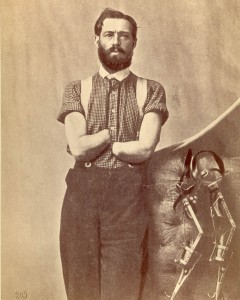
Private Samuel Decker. Courtesy of the National Museum of Health and Medicine.
Jake: Amputations are the obvious one. The Civil War saw a tremendous amount of amputations being performed on the battlefield. The weaponry being utilized (heavy, slow-travelling, lead bullets called Minie balls) shattered bone like glass. The only course of action for surgeons treating these cases was to amputate the affected limb.
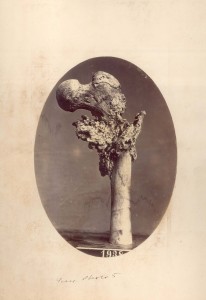
Courtesy of the National Museum of Health and Medicine
Amelia: Flash forward (or is it backward) to the Star Wars universe, and we have the lightsaber and blasters. In many ways, minie balls and lightsabers and blasters are as different as they can be. But they’re similar in that they both cause devastating damage, necessitating (in the case of the minie ball) or causing (in the case of the lightsaber) amputation.
Jake: Absolutely. While there are a few cases during the Civil War when a limb is immediately severed from a body, in most case the minie balls are just damaging the limbs beyond repair. In this case, Star Wars amputees have the advantage. Their wounds are instantaneously cauterized, meaning that the bleeding stops and infection isn’t a problem.
Infection was a major reason why Civil War battlefield wounds were so frequently fatal. Germ theory was in its infancy. Civil War surgeons lacked knowledge of microbiology, meaning most if not all open wounds, became infected. Those infections could kill in a matter of hours or could be a slow-burn, taking weeks to spread through the body before finally killing the soldier.
Amelia: But, not everyone wounded on the Civil War battlefield dies.
Jake: Certainly not. For those that survive battle and amputations, surgeons have to figure out how to give them the best quality of life possible … which leads us to our next connection.
Amelia: Prosthesis.
Jake: Prosthetic limbs help give amputees a measure of normalcy in their lives. The prosthetic industry flourished during and after the Civil War and great advances were made in the field throughout the latter half of the 19th Century. For Civil War amputees, prosthetics were oftentimes just wooden arms or legs that gave them the ability to do very basic things like walk or pick up objects. A far cry from Luke’s indistinguishable arm or Vader’s prosthetic body.
Amelia: For Civil War soldiers, that sort of convenience and technology would have been unimaginable. Today that’s a different story. In fact, Luke’s prosthetic hand was a major inspiration for one of the latest iterations of prosthetic hands. Previous to this innovation, prosthetic hands hadn’t changed much since the 19th century.
Jake: So, we’ve talked a lot about the connections between medical technology. What about the people?
Amelia: I’m so glad you asked. One of the most interesting connections I see is between Princess Leia and … of all people … Clara Barton .
Jake: Well of course there’s the hair.
Amelia: Absolutely. Princess Leia’s awesome hair needs no introduction. People have spent a lot of time trying to figure out where the inspiration for Leia’s hair comes from. No one mentions Clara Barton, and rightfully so. I’m not claiming that Barton directly influenced Leia’s hair, just that in some cases they are eerily similar. So why bring it up? First of all, Clara’s hair is one of my favorite things about her. We tend to think of Clara as this selfless, saintly woman.
Jake: The Angel of the Battlefield.
Amelia: But Clara isn’t an angel … she’s a real person. She has selfish motivations, in addition to her selfless ones. She not always thinking of others. For one, she’s really vain … particularly in regards to her hair. On one occasion, she’s preparing to go to the front and she urgently sends away for hair product, lest battle not affect her hair do. Her vanity doesn’t mitigate how badass she is, if anything it emphasizes her ability to kick butt and take names and makes her more real.
Jake: The same goes for Leia. She’s a take charge woman who is always in the fray and just happens to have awesome hair. Now that I think about it they have very similar personalities.

Jake: I’ll say. It strikes me that Clara would have loved to be Leia. Over 400 women disguised themselves as men to fight in the Civil War, but Clara wanted to remain her idea of a “proper lady.” She would have been so jealous of Leia’s ability to do both.
Amelia: Absolutely. Wanting to be Princess Leia is something Clara, my younger self, and a lot of young women have in common. In so many stories we tell, either fictitious or historical, women are either absent or relegated to the sidelines. Leia is neither of those things, nor is Clara. They are both people who are unapologetically in the middle of the action. They are risking their lives and making a difference. The guys would be lost without them.
Jake: Here, here.
Amelia: Speaking of “being lost without them” though … you realized perhaps the biggest connection between Civil War medical personnel and Star Wars.

Amelia: This was one of the most incredible things I learned when I started working at the museum. We didn’t always have a system of medics, evacuation, and triage in battle. That had to be organized and put into effect, and Letterman does that and is incredibly effective.
During the Battle of Antietam on September 17, 1862, the deadliest day in American history, Letterman’s medical corps ensured all of the wounded were retrieved and receiving medical care within 24 hours of the fighting. Previously, wounded would lie on the battlefield for days waiting for care.
Jake: I don’t think we can overstate his contribution. His revolutionary ideas became the official policy of the military in 1864 and military medical officer who served during World War II wrote that “there was not a day during World War II that I did not thank God for Jonathan Letterman.” So yeah, important guy.
Amelia: But what’s the connection to Star Wars?
Jake: After the Civil War, Letterman heads out to California where he practiced as a doctor and became the coroner in San Francisco. He died there in 1872. But since he innovated the way the U.S. Army did battlefield medicine …
Amelia: Really emergency medicine in general …
Jake: With all this, he had to have a military base named for him. Letterman Army Hospital was built in San Francisco 1898 and operated until 1994. The U.S. Army abandoned the property, and it is divided up, parts are redeveloped, others are repurposed. Part of the grounds that were once the Letterman Army Hospital are now the Letterman Digital Arts Center, operated by … who else …George Lucas. The Letterman Center is now home to LucasArts, LucasFilms, and the Industrial Lights and Magic. The filmmaker who gave us a Galactic Civil War has set up shop on the site of a military hospital named for a Civil War doctor who changed American medicine forever.
Amelia: Of all the gin joints in all the world … That connection really seals it. If you’re a Star Wars fan, you’ve just got to come to the museums.
